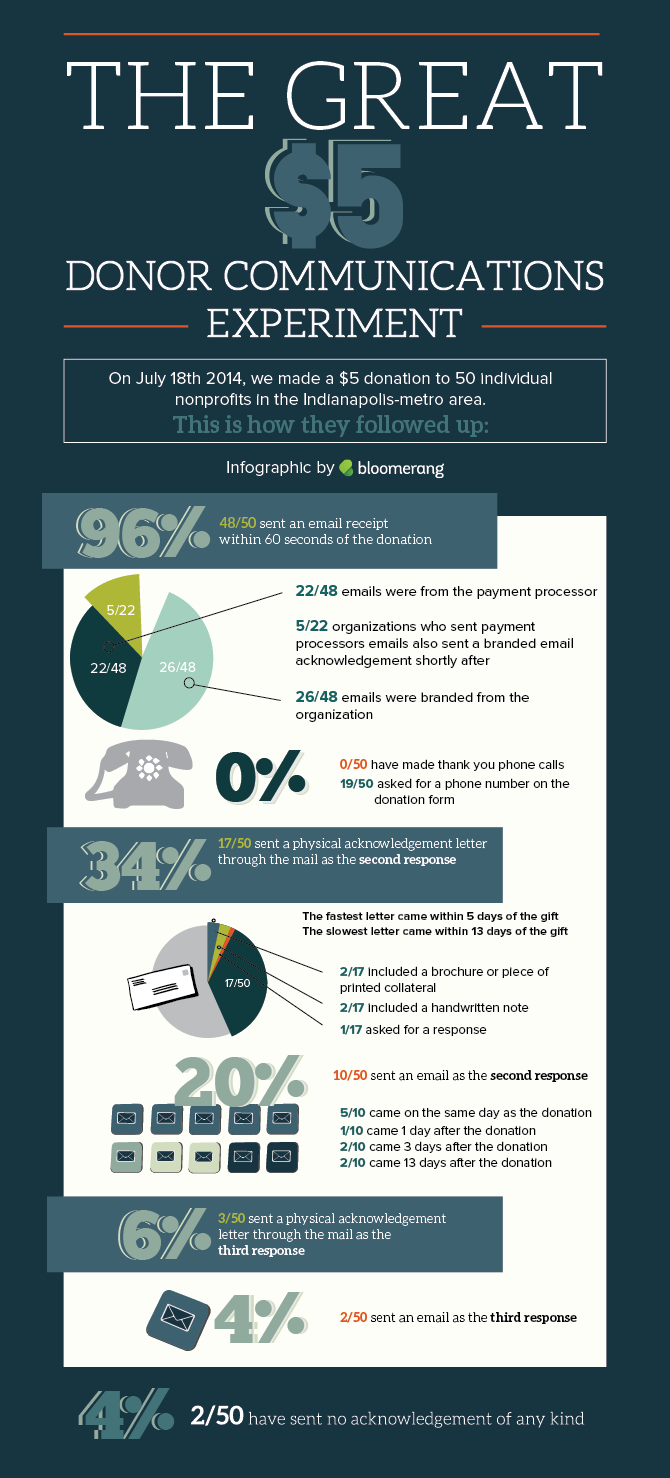If you’re not retaining as many donors as you’d like, you’ve no one to blame but yourself. And I’m here to tell you why.
You’re not thanking donors properly.
I’m serious. How you handle donor acknowledgements is that important.
Sadly, most nonprofits do an absolutely rotten job of showing donors how much they are appreciated.
Part of the problem is due to focusing on acquisition at the expense of retention. Most executive and development directors don’t even know their retention rates without looking them up. According to Jay Love, founder of Bloomerang, less than 45% of fundraising offices know this answer!
So, you’re not alone. But you can do better.
DUDES! Your retention rates should be on the tips of your tongues! If you don’t know how you’re doing, how can you improve?
If you’re the average nonprofit you’re retaining only 23% of first-time donors and 46% of ongoing supporters. In other words, imagine you brought in 1000 new donors last year. Sounds good, no? But… those 1,000 will shrink to 230 this year. And to 106 in the next year. After five years you’ve got only 10 folks left. I’m NOT KIDDING! You’re on a treadmill. In and out. In and out.
Knowing your retention rate enables you to move it to something better. A lot better.
Did you know a 10% increase in donor retention can increase the lifetime value (in dollars) of your donors by as much as 200%? There are numerous donor retention strategies you can, and should, use. But here’s the Daddy of them all:
Assure Donors they Made a Good Donation Decision
Sending them an impersonal formal receipt won’t accomplish this. Nor will waiting a week or more to acknowledge their gift.
Put some significant thought and effort into expediting and exceptionalizing the thank you process.
If you can stand out — in a good way — It’s amazingly powerful, and can have a remarkable impact on your bottom line.
Wondering how other nonprofits handle saying thank you? The folks at Bloomerang conducted an experiment to see how 50 randomly selected nonprofits in the Indianapolis-metro area responded to their first-time $5 online gifts. See the results in the accompanying infographic.
What do you think? Good or bad?
I think the online response should be 100%. And the offline response should be much, much better.
The results of this experiment prompted me to share a few of my most fundamental rules of charitable donation acknowledgments with you. If you’re not doing at least the bare minimum, you’re truly wasting your time even acquiring these donors. Remember the treadmill analogy. In and out, in and out. Yipes, yipes, yipes!
I’m betting you can’t afford to waste your precious resources losing donors almost as fast as you acquire them.
So…
Put Some Noticeable Thought into Your Thank You Program!
Yes, I said noticeable. The thought should be apparent to your donor! The thank you should make them feel genuinely good. You may know MRI studies have revealed when people give, the pleasure center of their brain receives a jolt of dopamine akin to the pleasurable feeling folks get when engaging in sex or eating chocolate. Alas, this warm glow doesn’t last long. It needs to be reinforced. At least if you want folks to feel like giving again. A pro forma receipt won’t cut it.
Life corollary: I’m not a fan of Hallmark cards sent simply with a signature. If you’re sending a card you should at least take the time to write something personal. Otherwise the message you’re sending is “I really can’t be bothered to think of something to say.” The card was merely fulfillment of a chore. Chores are unpleasant, both for the sender and the recipient. The message received is exactly the opposite of the message intended.
Okay, let’s get to it. Some of my rules may seem over the top to you. If so, I want you to tell me what your donor retention rate is. If it’s not significantly better than the average, then you’ve got some changing to do. And if you change nothing else in your donor acknowledgement process, change these three things.
3 Rules for Thanking Nonprofit Donors that Should Never Be Broken
1.PROMPTNESS MATTERS
For online donations, this means immediately. Today’s consumers are accustomed to fast turn-around. If Amazon can ship to them in 24 hours, surely you can say thank you faster than that! Send folks immediately to a Donation Landing Page that thanks them for their gift and let’s them know they’ll receive an emailed receipt shortly. With the right database, CRM and/or email service provider, you should be able to automate this so it happens almost instantaneously. But it shouldn’t look canned. Be sure to take the time to customize it based on the campaign to which they responded and the amount they gave. And address them by their first name. People need to know (1) their transaction went through, (2) it was appreciated, and (3) you can be counted on to be a good steward of their investment. If you’re lazy about saying thank you, they’ll presume you’re lazy about everything else as well. In other words, you’ll shoot yourself in the foot before you’ve even started. And that’s why almost 8 out of 10 first-time donors, and almost 6 out of 10 ongoing donors, never renew!
TIP: Don’t let your online donors suffer just because they chose to give via your website. Make sure they also receive a mailed thank you letter, with all your inserts and personal notes (which I’ll talk about below). I hate to see online donors treated differently than offline donors. In the Bloomerang experiment, only 34% sent a hard copy letter. If you’re among the minority like this, you’ll stand out! If you absolutely have so many online donors you can’t afford to mail thank you letters to all of them, then at least make sure you send them to the subsets of your supporters you’ve identified as most likely to be sustaining and/or larger donors (e.g., donors who give multiple times a year; donors who’ve given above a certain level, consecutively, for 3+ years; first-time $100+ donors, etc.).
For offline donations, this means within 48 hours. Again, remember the Amazon rule. To make this happen, you must get everyone in your organization to buy in to the 48-hour rule. Donor etiquette is not like wedding etiquette. You don’t have a year to send the thank you note. You have 48 hours. No kidding. This is perhaps the most important thing you can do to sustain donor relationships. But if anyone doesn’t take this seriously (e.g., finance department who processes gifts; executive director who signs letters; development staff who input gifts and output/proof letters; staff who pick up and deliver the mail) it won’t happen. And if you can’t make this happen, you’re going to lose donors. Period.
TIP: Don’t let higher level donor letters take longer to get mailed because they sit on the director’s desk for a week waiting for a personal note. Absolutely include that note, but figure out a system to avoid this type of delay and make it part of your donor acknowledgement policies and procedures.
2. PERSONALIZATION MATTERS
The more you can show donors you know them, the better. No one enjoys being part of an amorphous mass. Even if they’re brand new donors, show them you know this much! It saddens me so few nonprofits in the experiment took the opportunity to properly welcome new donors to their community/family. Remember, a gift is the beginning of a budding relationship; not a singular transaction. All the best fundraising is about building personal relationships. For the relationship to blossom, give and take is required. Too many nonprofits are just “takers.” Be a “giver.”
TIP: Send a Welcome Packet to reinforce the donor’s decision to invest with you. Include a few inspiring stories. Also include information that lets folks know you welcome their involvement beyond just their monetary support (e.g., notices of upcoming events; invitation to a tour; volunteer opportunities). Then, put a personal note on the letter. Even if it’s just “Thanks for your support” in handwriting next to the signature, it’s a gesture showing you actually took some time signing the letter. It wasn’t all done by machine. I’ve tested this, and folks who receive personal notes renew at a much higher rate than those who do not.
3. PICKING UP THE PHONE IMPRESSES
A genuine, personal, pure thank you call is a rarity today. I know people screen their calls. Yet the fact it’s coming from you, right after the donor made a gift, may mean they’ll even pick it up and talk to you. If not, you can leave a brief voicemail message. No ask. Just a warm thanks! Either way, your donor will be impressed. And they’ll feel good, thinking “wasn’t that nice?”
It seems pretty nutty to me that in the Bloomerang experiment only 38% asked for a phone number. You want to be able to communicate easily with your donors folks! Not a single nonprofit of 50 called to thank the new Bloomerang donors. I know, you’re thinking it was just a $5 gift. Suppose it was a $100 gift. Would you call to thank then? If you’d ever given $100+ for the first time to any nonprofit for which I worked you’d have received a phone call.
TIP: Experiment making calls to a percentage of first-time donors below $100. For example, randomly call one out of five new donors who give between $50 – $99. Track them over a 24 month period. Did the folks who received calls in Year One renew at a higher rate or level in Year Two than those who did not receive a call? If so, you’ve justification to do this for all donors at this level in Year Three. Not sure what to say? Pick up my free e-book on donor thank you calls . If you’re a small nonprofit, why not call every single donor? What better way to get to the point where you’ve too many donors to call all of them?!
Commit to Never Break these Rules!
Put a plan in place to thank donors in a manner that will get them to give to you again.
- Prompt thank you.
- Personal thank you.
- Pure thank you phone call.
Remember: Your prompt, personal thank you builds a bridge to future support and deeper engagement. Do it well, and you are on your way to future fundraising success.
The Power of Thank You Cannot Be Denied!
 If you want to develop a strategic donor acknowledgment program, check out How to Cultivate An Attitude of Gratitude and Keep Your Donors. For more on this topic, get, 48 Hours: Your Donor Acknowledgement Solution Kit. All Clairification products have a 30-day no-questions-asked 100% money-back guarantee.
If you want to develop a strategic donor acknowledgment program, check out How to Cultivate An Attitude of Gratitude and Keep Your Donors. For more on this topic, get, 48 Hours: Your Donor Acknowledgement Solution Kit. All Clairification products have a 30-day no-questions-asked 100% money-back guarantee.
Image courtesy of Freedigitalphotos.net. Infographic courtesy of Bloomerang.








You are absolutely right. Saying thank you to someone or donors is one of the simplest yet most powerful things humans can do for each other. Thank you so much for sharing your ideas.
Thank you. You are right. A lot of good fundraising is common sense.
Thanks for a great article. Numbers don’t lie. I feel so convicted and provoked to take prompt action with donors from now on.
Thanks for reading and taking the time to comment. Much appreciated.
I am an avid follower of Penelope Burk who is the donor relations and research icon who actually first introduced the fundraising industry to the problem of donor attrition, how thanking new donors improves early retention, and especially how calling donors to say thank you inspires loyalty and higher gift value. She has also for years advocated controlled testing and carefully explained how to do it in her best-selling book, “Donor-Centered Fundraising”. In other words, everything in this post was published by her more than 15 years ago. So, I was disappointed that you did not give credit where credit is certainly due, to the real innovator who is responsible for not only alerting the fundraising industry to many issues that are holding giving back, but offering researched and tested solutions. And, she’s still doing it today.
I’m so sorry if I neglected to give credit to Penelope in this post. I link to her and to her book OFTEN, and credit her with totally changing my approach to fundraising when I first read her book and heard her speak — about two decades ago. Yes, she is awesome. And I thank you for pointing others towards her valuable resources. [BTW: If you do a search for ‘Penelope Burk’ on my blog you’ll be directed to numerous posts where I mention her. https://clairification.com/?s=penelope+burk%5D